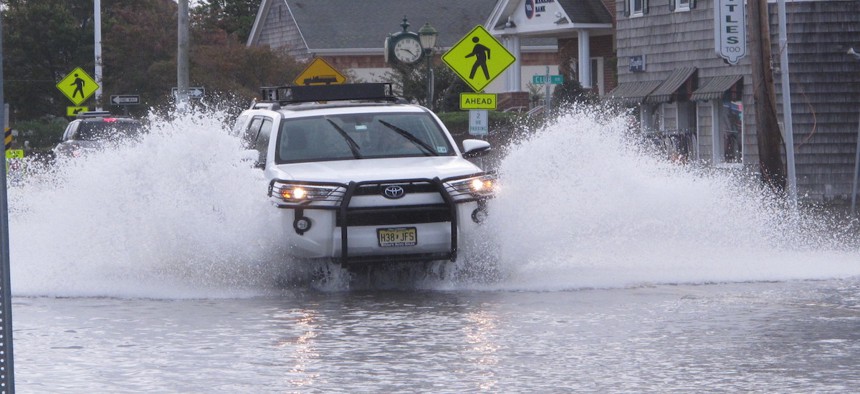Report: High-Tide Flooding Broke Records Last Year. It Will Probably Keep Getting Worse.

A car drives through a flooded road in Bay Head, N.J. on Friday Oct. 11, 2019, after a combination of high tides and strong winds caused minor to moderate flooding along parts of the shore. Associated Press
Nineteen locations around the country in 2019 set or tied records on the number of flood days, the National Oceanic and Atmospheric Administration found.
Coastal communities across the country saw record levels of high-tide flooding last year, a trend that is likely to continue as sea levels rise and water creeps further inland, the National Oceanic and Atmospheric Administration said this week.
“Sea level rise flooding of U.S. coastlines is happening now, and it is becoming more frequent each year,” scientists with the federal agency wrote in an annual report analyzing high-tide flooding. “This type of coastal flooding will continue to grow in extent, frequency and depth as sea levels continue to rise over the coming years and decades.”
The report reviews high-tide flooding data from the 2019 meteorological year and predicts trends for 2020. The meteorological year runs from May to April.
NOAA defines high-tide flooding, also called “nuisance” or “sunny-day” flooding, as water rising anywhere from 21 to 24 inches above the daily average high-tide mark. It can occur even on calm, sunny days, flooding shorelines, streets and basements, as well as impacting tourism and infrastructure, including septic and stormwater systems.
Nuisance flooding has increased dramatically due to rising sea levels, which were more than a foot higher nationally in 2019 compared to a century ago.
“As sea level rise continues, damaging floods that decades ago happened only during a storm now happen more regularly, such as during a full-moon tide or with a change in prevailing winds or currents,” the agency said.
Nineteen locations set or tied records for the number of days with high-tide flooding last year, including Sabine Pass, Texas, with 21 days of flooding; Corpus Christi, Texas, with 18 days of flooding; Annapolis, Md. (18 days); Charleston, S.C. and Savannah, Ga. (13 days each) and Dauphin Island, Ala. (10 days).
Those records represent large jumps in a relatively short period of time, researchers noted. For example, Sabine Pass, Texas, recorded just a single day of flooding in 2000, while Corpus Christi had three. Charleston did not record 13 total days of high-tide flooding in NOAA’s first 50 years of collecting data there, but hit that same total last year.
“NOAA’s National Weather Service is issuing record numbers of watches/warnings for coastal flooding, often with no storm in sight,” the report said. “This will become the new normal unless coastal flood mitigation strategies are implemented or enhanced.”
The report predicts an acceleration in high-tide flooding through next April, with a likely range of two to six days nationwide. The Northeast Atlantic and Western Gulf coasts are expected to be hit hardest, with a likely range of six to 11 and five to 11 days of flooding, respectively.
Absent immediate and large-scale improvements in flood-plain management strategies, those increases are likely to continue indefinitely, according to the report. By 2030, NOAA predicts that the number of high-tide flood days could double or triple nationwide. By 2050, that number could be five to 15 times as great, “which could, in some places, imply high-tide flooding would become the new high tide,” occurring up to 180 days each year.
"As a Chesapeake Bay resident, I see the flooding first hand and it is getting worse. Records seem to be set every year," William Sweet, an oceanographer for NOAA’s National Ocean Service and lead author of the report, said in a statement. "Communities are straddled with this growing problem.”
Kate Elizabeth Queram is a staff correspondent with Route Fifty and is based in Washington, D.C.
NEXT STORY: DISA looks to infrastructure as code for faster cloud deployment





